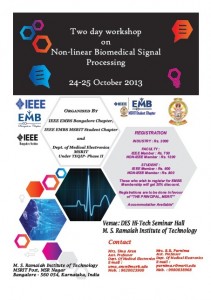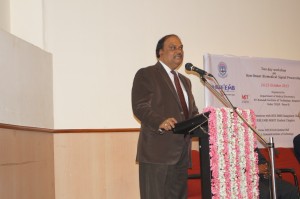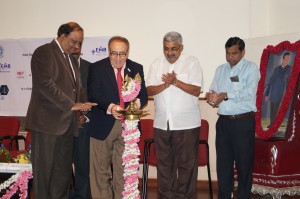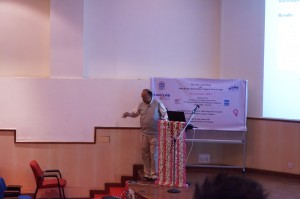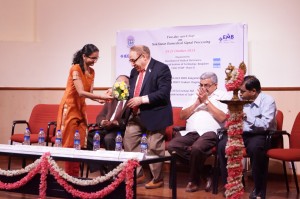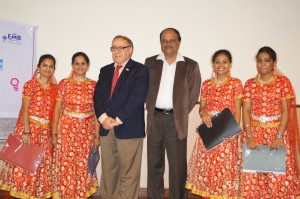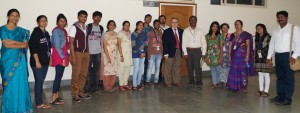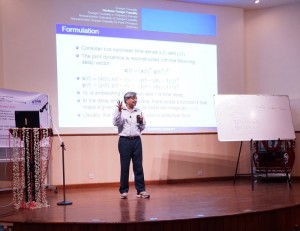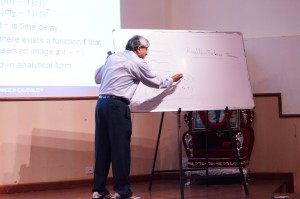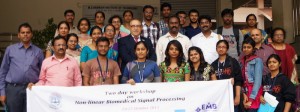With the ever increasing diagnostic and therapeutic methods available in healthcare today, apart from collecting the information from the human body, analyzing and processing of the obtained information is necessary. Since human body signals are mostly non-linear, it is important to accommodate various suitable techniques which help in processing of these non-linear signals to obtain accurate results.
The main goal of this workshop was to make the students aware of these techniques, its applications and convey their importance in designing a medical device. The overwhelming response through registrations made this workshop well attended by many prominent delegates. The encouragement from IEEE, IEEE EMBS Bangalore Chapter, IEEE EMBS MSRIT Student chapter and M. S. Ramaiah Institute of Technology to host such an event further made this event a grand success.
The Guest of Honour for the event was Prof. Metin Akay from the University of Houston, Texas, USA who is a pioneer in the field of biomedical signal processing. Dr. S.Y.Kulkarni, Principal, M. S. Ramaiah Institute of Technology welcomed more workshops like these to enhance the understanding of complex concepts in Biomedical Engineering.
Dr. S. Y. Kulkarni introducing the dignitaries
Dignitaries lighting thelamp
Day 1
Session 1:
DYNAMICS OF BODY MOTION AND MOTOR FUNCTIONS IN
POST – STROKE PATIENTS.
-By PROF. METIN AKAY, UNIVERSITY OF HOUSTON.
Dr. Akay shared his valuable experience in the field of signal processing and introduced the delegates to new topics in the field namely ‘fractals’ and their applications in the field of biomedical signal processing, ‘ probability density functions and scaling notes’. Each of these techniques were explained and their importance was conveyed.
Prof. Metin Akay addressing the gathering
Prof. Narayana Dutta interacting with the delegates
Session 2:
NON-LINEAR PROCESSING OF CARDIOVASCULAR SIGNALS WITH APPLICATIONS.
-By NARAYANA DUTTA, IISc, Bangalore.
Prof. Narayana Dutta introduced the delegates to some important topics which included ‘chaos as a deterministic behavior’, its sensitivity to its initial conditions, ‘Lyapunov exponent’ & ‘Hurst exponent’ and significance of each of the concepts. He introduced the basics of dynamics of heart and its electrical activity. ‘Correlation Dimension’, ‘Recursive Plots’ and ‘Chaotic systems’ were also introduced.
Session 3:
NON LINEAR DYNAMICS OF EEG – CHAOS THEORY APPROACH
-By Dr. N. SRIRAAM, HOD, DEPT.OF MEDICAL ELECTRONICS, MSRIT.
The significance of Biosignal Processing was discussed to enlighten the audience about the scope of such an important stream of Biomedical Engineering. In addition to this, concept of ‘Chaos’ was discussed. Clinical applications like ‘Brain Signal Studies’, ‘Compression’, ‘Seizure Detection’, ‘Anesthetic Depth Level Detection’ and ‘Alcoholic Detection’ were well conveyed with examples. He recommended non-loss procedures in biomedical systems as we need information at all time by not losing important the data.
Dr. N. Sriraam
Prof. Metin Akay
Session 4:
DISTINGUISHED LECTURE PROGRAMME
HYBRID BIONIC MAN
-By METIN AKAY, UNIVERSITY OF HOUSTON.
Prof. M Akay introduced the delegates to ‘Hybrid bionic man’ with various examples. He emphasized Global healthcare challenges and possible solutions. The audience was exposed to the latest technologies in ‘Neural Prostheses’ and their possible applications to help people with amputated limbs. He also emphasized the degree of complexity each of these techniques possess and also gave counter-examples to make them simpler. ‘Brain Implants’ was another interesting topic discussed which was extremely useful to understand both biological and engineering points of view of the technology involved in making them. Considering the future technology to be wireless in almost all fields, Prof. M Akay introduced the audience to a new concept called ‘Wireless neural micro systems’ and their applications. Topics on ‘Cognitive brain implants in hippocampus’ & ‘Sensory Neural Prostheses’ were also introduced. ‘Bionic eye concepts’ were explained in detail which included technical and biological aspects of it.
Session 5:
CULTRAL PROGRAMME
-STUDNETS OF MSRIT.
The students of M.S.Ramaiah Institute of Technology showcased their talents in co-curricular activities such as singing and dance to the audience which were very well appreciated. Megha Rani, Final year student, Medical Electronics commenced the cultural show with Bharatanatyam with utmost finesse and grace. It was followed by a song from the Third and Final year students. Then were the two folk dances exhibiting the rich cultural diversity in India from both Second and Third year students.
Cultural programme by students of MSRIT
Day 2
Session 1:
NON LINEAR DYNAMICS AND MODELLING IN BIOSIGNAL ANALYSIS.
-By MAHESH ANAND.S, SCIENTIFIC COMPUTING SOLUTIONS, Chennai.
He explained that Biosignals are 1 -D signals where amplitude is dependent variable and time is independent variable. Concepts of ‘Time Space & Nature of Biosignals’, ‘Stochastic and non stationary concepts’, ‘ Chaos’ as the state of disorder or disorganized was explained with EEG as an example. ‘Double component pendulum by Runge Kutta Model’, ‘ Dynamic Equation’ and concept of ‘Attractors’ were discussed.
Session 2:
NON LINEAR DYNAMICS FROM SUBSYNAPTIC VERDANUM TO NEURAL INTERACTION
-By SUSHMITHA ALLAM, IBM HEALTHCARE, Bangalore.
Ms. Sushmitha Allam explained the concepts from a biological point of view which helped the audience gain more insight into the signal processing concept. ‘Fundamentals of Neurons and Synapse’ was discussed. Experimental techniques like ‘Imaging of Calcium in Spine’, ‘Receptor Tracking’ and ‘Sub synaptic parameters’ were demonstrated. ‘Glutamine receptor’s importance for Neural Transmission’ was discussed. ‘Receptors’ were discussed in detail along with synaptic efficiency with its non-linear property. ‘AMPA-R Receptor Property’ was explained which was done using simulation.’ Glial cells mechanism’, ‘Modification of the neural signal and synaptic transmission’, ‘NMDA receptor’, ‘GABA’, ‘ Pain killer or Suppressor Receptor’ were also included in the discussion.
Session 3:
TIME SERIES ANALYSIS USING GRANGER CAUSALITY
-By GOVINDAN RANGARAJAN, IISc, Bangalore.
‘Granger causality’ has emerged in recent years as a leading statistical technique. He explained this concept in detail as Granger causality is a measure of causal or directional influence from one time series to another. ‘Non linear Granger causality in Time Series’ was discussed with equations. Non linear granger causality is the cause and effect which also relate to each other. ‘Non linear Granger causality in Frequency Domain’ was also discussed.
Prof. Govindan Rangarajan explaining the concepts to the audience
The workshop was successful in teaching various biomedical signal processing techniques to students. Their area of application and significance helped students not only to imbibe these techniques but also view them as an application in situations where signals need to be simplified to extract more information from them. The workshop was very well received by all.

